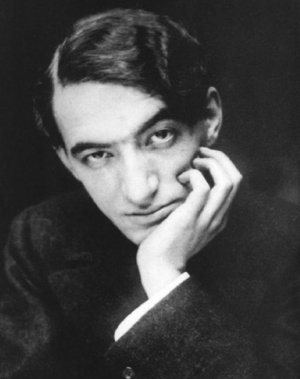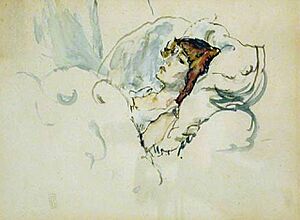Jules Pascin facts for kids
Quick facts for kids
Jules Pascin
|
|
|---|---|
 |
|
| Born | March 31, 1885 Vidin, Bulgaria
|
| Died | June 5, 1930 (aged 45) Paris, France
|
| Resting place | cimetière du Montparnasse |
| Nationality | America, French, Bulgarian |
| Education | Drawing in Vienna, Moritz Heymann's academy in Munich, Matisse Academy and Académie Colarossi in Paris |
| Movement | École de Paris, Expressionism |
| Spouse(s) | Hermine David |
| Partner(s) | Lucy Krohg |
Julius Mordecai Pincas (born March 31, 1885 – died June 5, 1930), known as Pascin or Jules Pascin, was a famous artist. He was born in Bulgaria and later became an American citizen. People often called him the "Prince of Montparnasse" because of his life in Paris.
Pascin was part of the School of Paris, a group of artists who worked in Paris in the early 1900s. He was known for his paintings and drawings. He often drew women in relaxed, everyday poses. Pascin studied art in Vienna and Munich. He also traveled in the United States, especially in the South. He faced challenges with his mood and sadly passed away at age 45.
Contents
Early Life & Art Training
Julius Mordecai Pincas was born in Vidin, Bulgaria. He was one of eleven children in a wealthy Jewish family. His father, Marcus Pincas, was a grain merchant. The family spoke a language called Judaeo-Spanish at home.
In 1892, his family moved to Bucharest, where his father started a grain company. When Pascin was fifteen, he worked for his father's business for a short time. He began his art training in Vienna in 1902, at age seventeen. In 1903, he moved to Munich to study at Moritz Heymann's academy. There, he met other artists like Paul Klee and Wassily Kandinsky.
In 1905, Pascin started drawing for Simplicissimus, a funny magazine in Munich. His father did not want the family name linked to these drawings. So, at 20 years old, Julius chose the name Pascin. This name was a mix-up of the letters in Pincas. He kept drawing for a Munich newspaper until 1929.
Moving to Paris
In December 1905, Pascin moved to Paris, France. Many artists moved to Paris at this time. He became friends with a group of artists called "Les Dômiers" who met at Le Dôme Café. They introduced him to Hermine David, who was also a painter. In 1907, Pascin and Hermine became a couple. That same year, he had his first art show in Berlin.
Pascin was very social, but he also created many artworks. He made thousands of watercolors, sketches, and drawings. He sold these to different newspapers and magazines. In 1908, Pascin began studying at the Matisse Academy. He often visited the Louvre museum. He especially liked the old masters from the 1700s, like Greuze and Watteau.
He showed his art in galleries and at big art events like the Salon d'Automne. Between 1905 and 1914, he mostly showed drawings and watercolors. He started painting around 1907–1909. His early paintings were influenced by Fauvism and Cézanne. He wanted to be a serious painter. He studied drawing at the Académie Colarossi and copied famous paintings at the Louvre. In 1913, his art was shown in the United States for the first time at the Armory Show in New York.
When World War I started, Pascin moved to London to avoid joining the Bulgarian army. He then left for the United States on October 3, 1914. Hermine David joined him there later that month.
Life in the United States
Pascin and Hermine David lived in the United States from 1914 to 1920, during World War I. They visited New York City, where Hermine had an art show. Pascin went to nightclubs and met artists like Yasuo Kuniyoshi. He spent most of his time traveling through the Southern United States. He also visited Cuba. He made many drawings of street life in places like Charleston and New Orleans. Some of his works from 1915 and 1916 had a Cubist style, but he soon stopped using it.
In 1918, Pascin married Hermine David in New York City. Their friends, artists Max Weber and Maurice Sterne, were witnesses. In September 1920, Pascin became a citizen of the United States. Soon after, he returned to Paris. There, he started a relationship with Lucy Vidil Krohg. She had been his girlfriend years before and had married another painter while Pascin was in America.
After returning to France, Pascin became a well-known figure in the Montparnasse art community. He was often seen wearing his bowler hat at places like Le Dôme Café. Pascin visited Bulgaria again in 1923 and 1924.
Artistic Career
Pascin often drew his friends and the people around him. He was known for hosting many big parties at his home. When he was invited to dinner, he would bring many bottles of wine. He often led large groups of friends on summer picnics by the Marne river. These trips would last all afternoon.
One of Pascin's friends in Paris was the writer Ernest Hemingway. In his book A Moveable Feast, Hemingway wrote about meeting Pascin and two of his young models at a café in 1923.
Pascin was friends with other artists of the School of Paris, including Chaim Soutine and Isaac Frenkel Frenel.
Art Style
Pascin's early works show his background as a satirical artist. They also show the influence of German expressionism. His portraits from this time are similar to those by Otto Dix, but less harsh. He soon developed a unique style using soft, almost dream-like colors. He used these colors skillfully to show the female body, which was a main subject in his art.
His lively drawing style used lines that only lightly outlined the body. This made his models look like they were bathed in a special light. This light showed their feelings more than just how their bodies looked. In this way, he continued the style of 18th-century masters who liked freedom in their art.

Later Life and Legacy
Pascin faced challenges with his mood for many years. He passed away at the age of 45, just before a big art show of his work. In his will, Pascin divided his belongings equally between his wife, Hermine David, and Lucy Krohg.
On the day of Pascin's funeral, June 7, 1930, thousands of people from the art world came. Many waiters and bartenders from the places Pascin visited also attended. They all wore black and walked three miles behind his coffin. A year later, Pascin's family moved his remains to the more famous Montparnasse Cemetery.
Honours
Pascin Point in Antarctica is named after Jules Pascin.
In 2023, the old synagogue in Pascin's hometown was reopened. It is now called the Jules Pascin Cultural Centre.
See also
 In Spanish: Jules Pascin para niños
In Spanish: Jules Pascin para niños
- Chaim Soutine
- Isaac Frenkel Frenel
- Marc Chagall
- Amadeo Modigliani
- School of Paris



